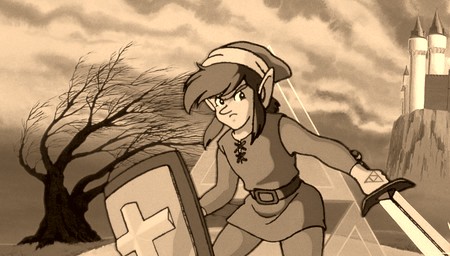Adventure of Link - A "post-RPG"
In Adventure of Link, the protagonist (Link) is already an adult, and this has certain implications in the context of the genre, filled with heroic adventures of teenagers that leave their home to fight evil and grow up during the journey. With the protagonist already having grown up and the victory against the enemy having already been reached before the events of the game, what comes after?
Adventure of Link focuses itself in adulthood instead, and its subversion comes from being a "post-RPG", a story that would come after what would happen in other RPGs, similarly to (and in certain ways a successor of) Quest of the Avatar. What this game does to accentuate this effect is the perspective shift, where the field of vision moves away from the avatar in a top-down view, blurring itself with less details, whereas the emergent events move closer from a lateral angle. This navegation system allows encounters with visible enemies on the map, trespassing caverns or discovering secret places to become and be distinguished as special stories. Examples such as abandoned ruins at the side of the beach, or lonely islets in the ocean become evocative precisely because they are not visible on the map, and finding them is a discovery. The feeling accomplished by this design is a bitter contemplation to the world, because the wide space without invitation to immediate pleasure alongside the presence of enemies stalking the protagonist imply a pitiless ambience where decay persists even after the defeat of the antagonist. What is being suggested is adult disillusion: The world is bigger than what we used to think as children, and is not our playground. One of the most representative moments of this intent comes after climbing the labyrinthine Death Mountain not very far into the game, when the player discovers that the most ferocious henchmen still inhabit there, and the small peninsula at the side of the ocean was the world of the first game.
The danger required to make this decaying situation closer to the player is conferred by the combat system, which is the greatest accomplishment of the game. The avatar can strike both from a high and a low angle, to the front, upwards or downwards in mid-air, dodge by hopping backwards, defend itself with the shield from different angles, etc. These actions are carried out manually, with no button to jump and do crazy acrobatics automatically like later action RPGs, which makes precision paramount to advance and survive. Given the focus on finding weak spots, each encounter becomes a personal duel, which attains intensity due to the necessity of reflexes and the speed of enemy attacks. This sensation is strengthened by the magic system which grants temporary upgrades such as damage reduction, better aerial maneuverability by an increased jump or flight to have more possibilities to approach or avoid enemies, and healing. The player must consider when to appropriately utilize their magic points and which spell to use, and tension arises when these points become scarce in the middle of a dangerous expedition. The avatar can also increase its stats by accumulating experience points by defeating enemies. When it reaches a certain amount of experience, the player can improve a certain category, or decide to wait for another improvement to become available, allowing in this way a decision according to the current circumstances. The matter is that if the avatar loses and is sent back to the starting point of the game, it loses all unused experience points (more radical than the current implementation of experience by FromSoftware many decades later), which makes waiting for the next benchmark for an improvement a source of tension. Since the enemies that the player encounters in the overworld surround the avatar in a pincer attack, encounters in palaces and cavers are unavoidable, and many places have instant death conditions, the suggestion of danger is a constant element in the ambience.
The final section of the game consists of the search for the Triforce of Courage, which is only deserved by someone who can prove to be worthy of its might, and takes a page from the climax of Quest of the Avatar. Link travels through the Valley of Death through a path of fire and brimstone to the summit of a volcano, where the Great Palace lies. His final trial is to face his own shadow, summoned from his own self, which is a resource associated with purification through dominance over oneself. It is then that the meaning of the journey as a personal encounter with adulthood is revealed. It is why it was called "The Adventure of Link".




Comments
Post a Comment